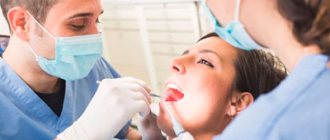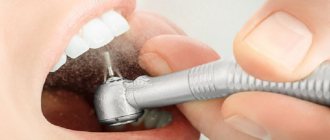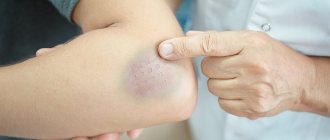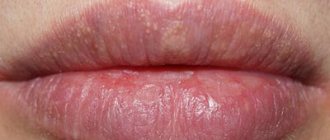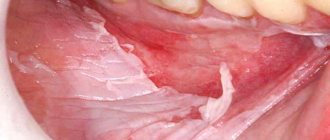The oral mucosa is a complex polymorphic system consisting of various tissues that perform complex functions. The mucous membrane lining the oral cavity is not the same over the entire area. So, it can be keratinizing and non-keratinizing, pliable and immobile. The keratinizing mucosa covers areas that are subject to pressure when exposed to chewing load; this is a kind of adaptive mechanism. Such areas in the oral cavity are the gums and the hard palate. The remaining areas are not so much subject to stress and injury and, therefore, do not need powerful regeneration. Another criterion by which the distribution of the oral mucosa occurs is compliance, that is, the ability of the mucous membrane to gather into folds. This ability is determined by the presence of a loose submucosal layer. It is most powerful at the bottom of the mouth and especially on the cheeks. Therefore, due to its mobility, the buccal mucosa often becomes a site of localization of various types of pathologies, some of which may be dangerous.
The reasons for the appearance of this formation
A blood bubble on the tongue is nothing more than a hematoma.
The epithelial tissues located above the wound are stretched, which, combined with the effect on the nerve endings, results in severe pain. Vascular rupture is the main cause of a blood bubble on the tongue.
Provoking factors can be divided into two groups:
- Pathological.
- Traumatic.
As a rule, blood vessels rupture if the integrity of the mucous membranes is disrupted.
Factors may include:
- Thermal impact. A fluid-filled blister on the surface of the tongue may represent a common burn caused by drinking hot food or tea.
- Chemical damage. The circulatory network located in the oral cavity is very sensitive to the effects of external irritants. Carbonated drinks that contain flavorings and dyes, salty, spicy foods - all this can have a detrimental effect on sensitive mucous membranes. Why does a blood blister form on the side of the tongue?
- Mechanical injuries. Chips, grilled meats, fish bones, and candies are typical enemies of healthy mucous membranes in the mouth. Hard and sharp food components can puncture blood vessels, thereby causing hemorrhage. Often such phenomena are observed in children under 3 years of age who are trying to taste everything. In addition, there is a high risk of mechanical injury when visiting the dentist.
The formation of a blood bubble on the tongue is a normal protective reaction of the body to an external irritant.
Blood blisters
The cheeks, due to their vital importance, are well protected, this is how it happened evolutionarily. Therefore, the muscle and mucous tissue of the cheeks are well innervated and richly vascularized, that is, supplied with blood. However, it also happens that this seemingly useful process becomes a problem. Many people are faced with the fact that a blood ball appears in the mouth on the mucous membrane of the cheek. Often such formation does not foreshadow anything dangerous. A blood bubble that forms in the mouth on the cheek is just the result of a mechanical injury. Most likely, the cheek area was bitten by the teeth while eating or talking. Since the oral cavity is a complex biological system in which a huge number of microorganisms live, it is natural that when such a microtrauma occurs, it becomes contaminated with various kinds of pathogens. As a result, a whole cascade of body responses is activated:
- since the pathogen is a foreign substance in the inner layer of the cheek, the immune system is immediately activated. Leukocytes, monocytes and macrophages quickly arrive at the site of infection, capture the pathogen and destroy it, and often die themselves;
- due to the death of immune cells that have absorbed pathogenic microflora, their internal contents are released into the environment. These biologically active substances are chemotaxis factors, that is, they signal to other cells, as a result of which substances such as histamine, serotonin, bradykinin - inflammatory mediators - are released in the area of inflammation;
- inflammatory mediators cause spasm of the circulatory system, which makes blood flow difficult; and after some time the vessels relax, and all the blood that has accumulated at the site of narrowing immediately flows into the source of inflammation. Since such blood flows at high speed and under high pressure, it forms a detachment of the mucous membrane - a bubble - and a blood ball appears in the mouth.
Thus, the blood blisters that form in the mouth are just part of the body's defense mechanism, which has been formed over centuries. When such a pathology appears, you should not panic too much. Regular blood blisters reorganize on their own within 3-4 days. But if the blood bubble does not self-destruct within a week, consult a dentist to rule out the diagnosis of unwanted neoplasms. The doctor will not only prescribe a pain reliever (since the appearance of a neoplasm on the mucous membrane is sometimes accompanied by pain), but will also take a sample of the epithelium for histology analysis.
How to assess the degree of injury?
The degree of trauma can be assessed by the nature of the contents in the bladder and its size. The blisters, which are quite large in size, are filled, as a rule, with serous fluid or blood. Small blisters are most often filled with colorless serous fluid. This may indicate that the blood vessels were not damaged. Such formations usually do not require conservative therapy or surgical intervention.
Based on their location, blisters are classified as located on the inner buccal wall, on the root of the tongue, on the side, under the tongue, or in the middle of the tongue.
Symptom of this pathology
Quite often, a blood bubble on the tongue is a symptom of other pathologies, including autoimmune, hematological, and viral diseases:
- Herpes. A herpetic blister can appear anywhere on or under the tongue. Additional signs of herpes infection may include fever, headache, and body aches. The blister of herpes origin is filled with colorless contents. Within two to three days it decreases in size and looks like a pimple.
- Stomatitis. The most common cause of bloody blisters on the tongue is stomatitis. As a rule, the disease affects pediatric patients, but situations when stomatitis develops in adults cannot be excluded. The course of the disease is accompanied by severe pain, increased temperature, and the appearance of blisters over the entire surface of the mucous membrane. Why blood blisters appear under the tongue is of interest to many.
- Herpetic sore throat. The blisters in the throat that occur with herpetic sore throat can spread to the tongue. In particular, at its root.
- Diabetes. With diabetes, the vascular system becomes highly vulnerable. The walls of blood vessels lose their elasticity and ability to fully conduct blood. In this regard, in the most vulnerable place - the tongue - there is a rupture of blood vessels and a subsequent outpouring of blood.
- Pemphigus. A blood blister on the tongue may indicate the development of pemphigus in the body. This disease is quite dangerous and does not exclude death. A characteristic symptom is epithelial detachment, accompanied by the formation of blisters. After opening, the blisters heal for a long time and painfully, often complicated by erosions.
- Syphilis. Blisters filled with blood may be a symptom of syphilis. The disease often affects the oral cavity and in the initial stages of its development is manifested by the appearance of a rash in the area of the tongue and throat. Blisters filled with blood can also occur in later stages of the disease. In order to differentiate sexually transmitted pathology, laboratory testing of blood samples should be carried out for the presence of Treponema pallidum.
- Hemangioma. With hemangioma, abnormal growth of vascular tissue and subsequent tumor formation are observed. The disease is very life-threatening. Clinical practice does not have data on cases of hemangioma transformation into a malignant tumor; however, it is very important to stop the growth of the tumor in a timely manner. Externally, a hemangioma looks like a blood bubble resulting from injury. However, after a few days the tumor begins to grow. A blood bubble under or on the tongue can grow to such a size that it becomes capable of blocking the air flow in the respiratory system. Self-puncture of the bladder can provoke severe blood loss, since the vessel has an increased size.
- Angiosarcoma. Some blisters that appear on the tongue may be malignant. Kaposi's sarcoma is a very rare cancer. Externally, Kaposi's sarcoma looks like a hematoma in the oral cavity, but, unlike a bladder, the tumor has a heterogeneous structure and uneven edges. The disease in most cases is a complication of AIDS and indicates infection with HIV infection.
The mechanism of formation of bubbles in the mouth
A blister on the inside of the cheek is a hematoma, or bruise. It is a small, from a few millimeters to a couple of centimeters, rounded formation. The internal exudate is serous or bloody, depending on the extent of the injury. In the first case, the blister is gray-white, in the second it is red, with a possible bluish tint.
Blood blisters appear due to injuries to the mucous membrane. Their formation is a natural reaction of the immune system to an irritant. It consists in:
- Activation of the body's defense mechanisms in response to an irritant. Agranulocytes arrive at the site of the lesion: leukocytes and monocytes. The latter, when leaving the blood into the tissues, are converted into macrophages. These cells capture the pathogen, neutralize it, and then die.
- The death of agranulocytes leads to their release to the site of injury. This process is a signal of injury to the body. After which it begins to release histamine, bradykinin and serotonin into the affected area. They sharply increase the permeability of blood vessels.
- A spasm occurs at the site of injury. The blood flow becomes difficult, after which the vessels relax and the blood accumulated during the narrowing enters the injured area. It moves quickly and under pressure. As a result, the upper layer of the epithelium peels off and a blister filled with bloody contents forms.
Blood blisters appear due to injuries to the mucous membrane.
Important! The red or white growth is not dangerous. It is virtually painless and heals within a week. The only discomfort is associated with inconvenience when chewing and talking.
What to do if a blood blister appears
If the blood bubble formed in the mouth is small and isolated, then there is no need for special therapy. Over time it will go away on its own.
However, the likelihood of spontaneous resorption without surgical or therapeutic intervention decreases as the formation grows.
Therapy is necessary if the blood blister is located directly near the frenulum. This area contains the salivary glands. It is extremely important that their functioning is not disrupted.
Treatment or what to do if a blood ball appears in the mouth
A blood ball in the mouth, as a reaction to external or internal irritants, goes away on its own within seven days. If this does not happen, then you should contact a specialist who will diagnose and prescribe treatment. It is important to determine its nature, fullness, size and location.
Most often, conservative therapy (less often surgical intervention) is carried out with the help of antiseptics (Chlorhexidine or Miramistin), which prevent the spread of bacteria, heal the wound and the blood ball resolves.
Conservative therapy for this pathology
Conservative therapy for a blood-filled blister at home should be aimed at relieving unpleasant symptoms and maintaining oral hygiene.
If the vesicle causes discomfort or itching, the use of antiseptic drugs in the form of a solution is allowed:
- "Chlorhexidine."
- "Miramistina".
- "Furacilina".
After each meal, it is necessary to sanitize the oral cavity.
A popular disinfectant is hydrogen peroxide. For local treatment and rinsing of the mouth, a solution with a concentration of 1 percent should be used.
The following drugs will help improve blood circulation and relieve swelling: “Cholisal”, “Kamistad”, “Metrogil Denta”. In order to relieve pain, the use of lidocaine-based medications intended for topical use is allowed.
Tea tree oil
Tea tree oil has an antiseptic effect. When using the drug, itching, swelling, and irritation are eliminated. It is important to note that this product is absolutely harmless for children and pregnant women. For therapeutic purposes, the blood blister must be lubricated with oil every hour. A few drops should be used.
The following decoctions are also effective: sage, oak bark, chamomile, St. John's wort. The decoction can be used for compresses and rinses.
Aloe
A paste made from aloe leaves can have a good effect. The pulp of the leaf should be crushed and applied to the blister for 15 minutes. It is recommended to repeat the procedure three times a day.
You should not pierce the bubble with a needle in order to speed up its resorption. On the contrary, before being examined by a doctor, it is necessary to avoid not only deliberate puncture of the blister, but also arbitrary one.
What should you not do when blood blisters appear on your tongue?
Unacceptable actions
It is strictly forbidden to ignore existing blisters if they are large or multiple. You can get advice on blistering rash from a therapist or dentist.
It is permissible to treat blisters filled with blood at home only if they are not a specific manifestation of any disease.
Syphilis, stomatitis, herpes, herpetic sore throat should be treated in a targeted manner, under the close supervision of a doctor. You can be confident in the diagnosis only after a complete examination by a specialist.
Do not try to puncture the bubble and extract its contents. Failure to comply with sanitary standards can lead to infection and bleeding.
Treatment
It is not necessary to treat blood blisters that form on the buccal mucosa. But if they bother you a lot, then you can puncture such blisters. It is better not to carry out such punctures on your own, especially if you are not sure of the diagnosis, so as not to harm yourself. In addition to punctures, you can rinse the mouth with antiseptic solutions - for example, chlorhexidine, furatsilin; You can use oral baths with decoctions of chamomile herbs or oak bark - these solutions will relieve local signs of inflammation. In addition to all this, it is believed that the development of such blood blisters occurs due to the weakness and fragility of the blood vessels. To strengthen the walls, you can use B vitamins, vitamin A, E, K, C inside. It will not hurt to stimulate and maintain the immune system, especially in the off-season, when the supply of micro- and macroelements to the body is reduced. Complex multivitamin preparations, which already contain all the necessary substances in the required quantities, are perfect for such purposes.
